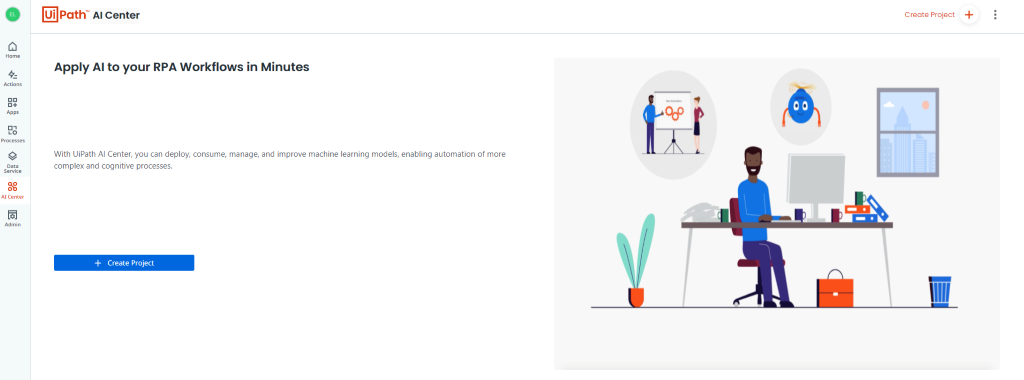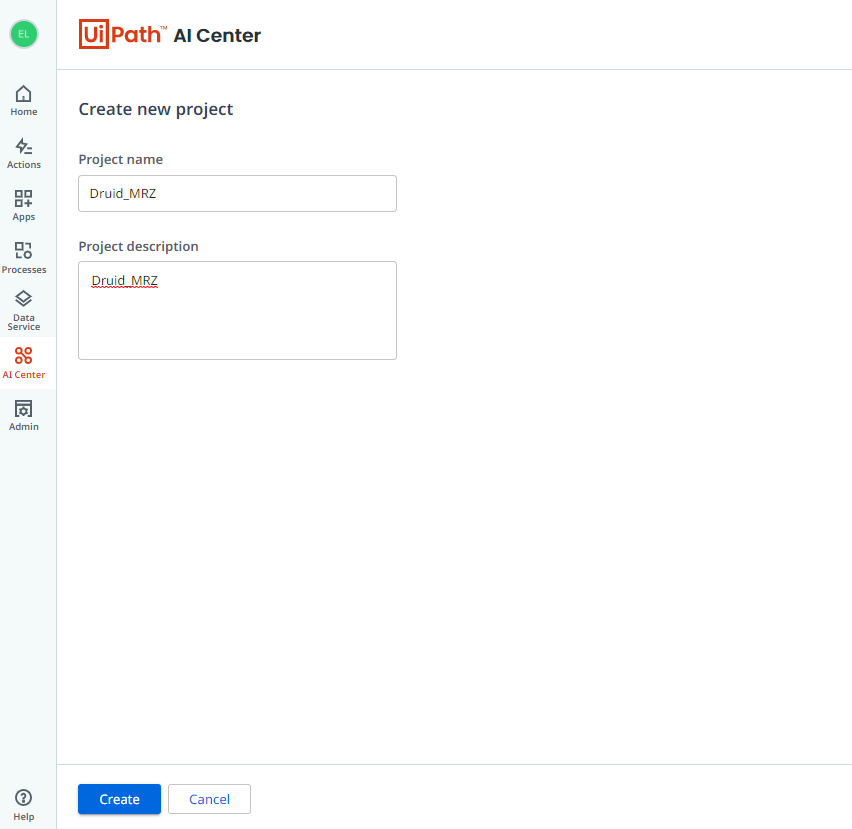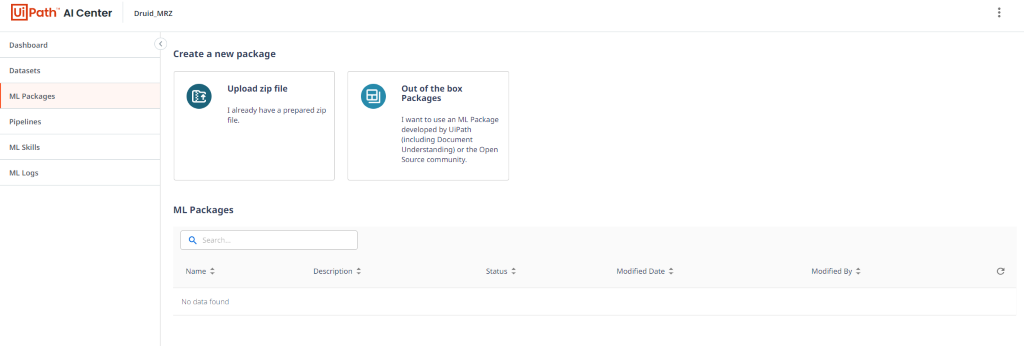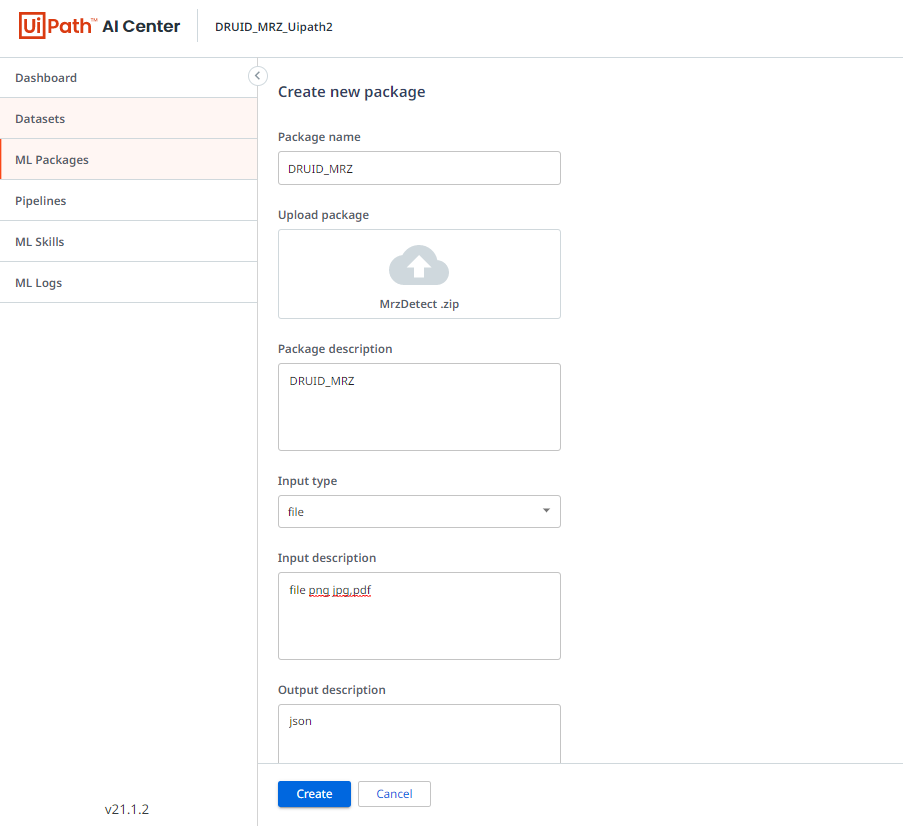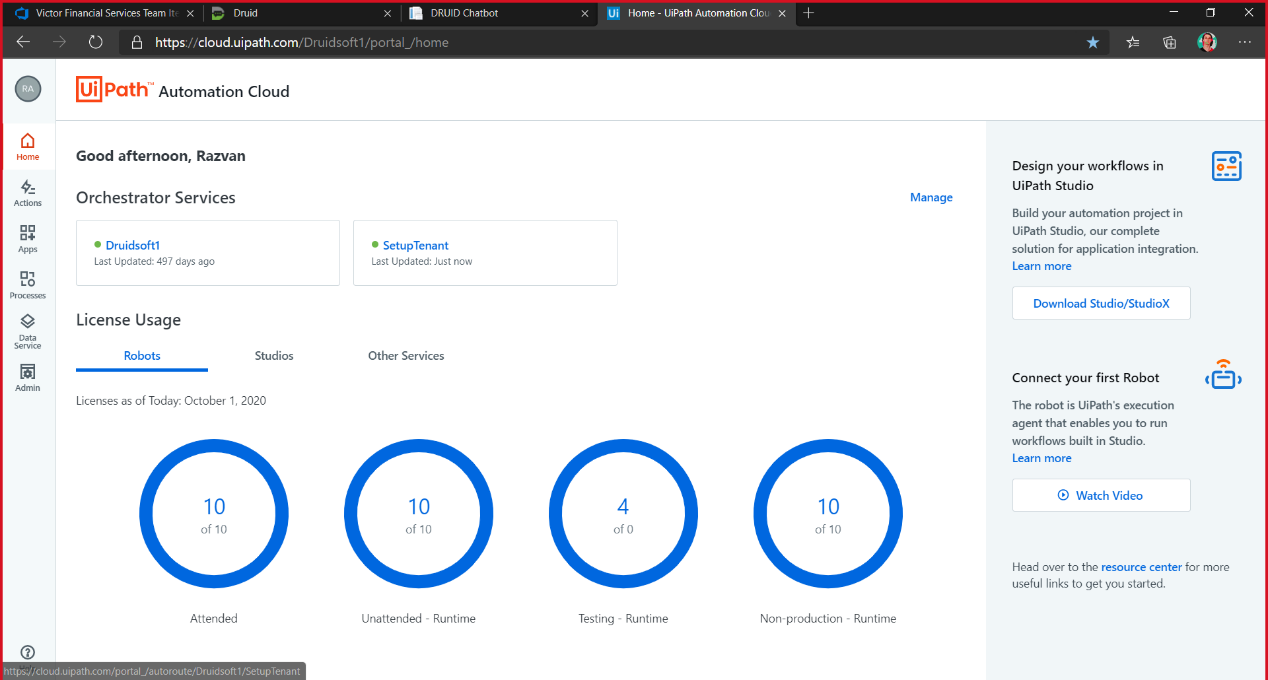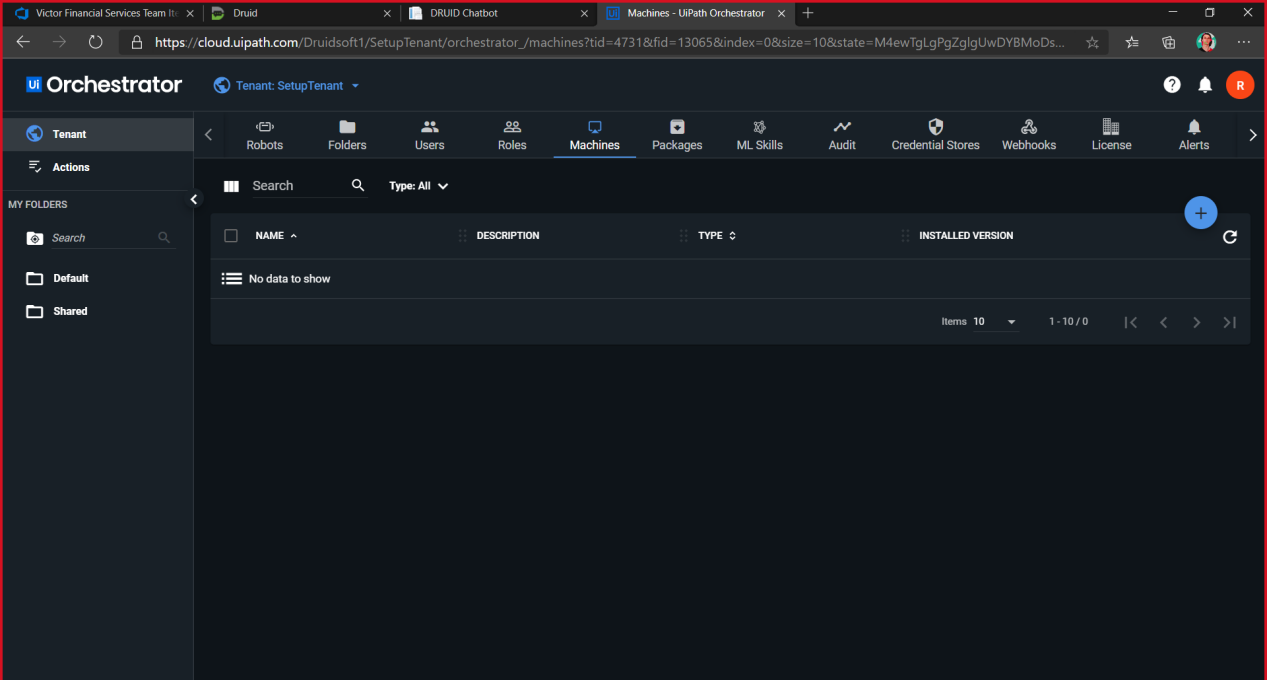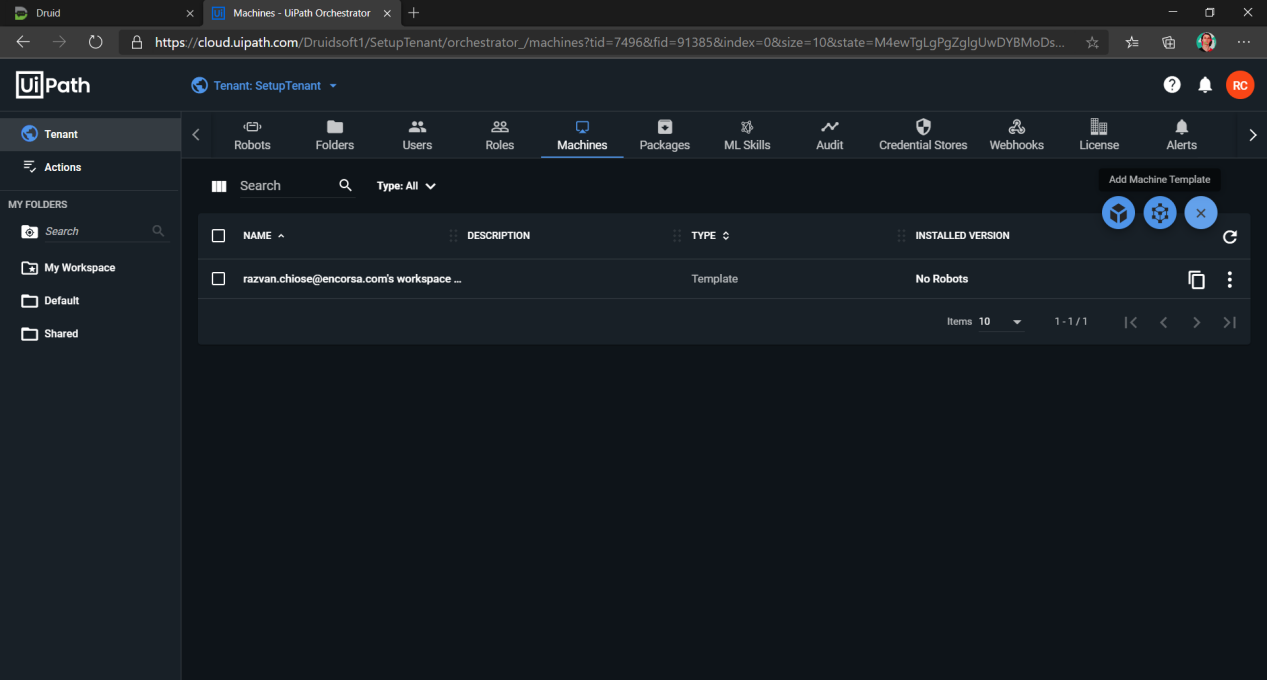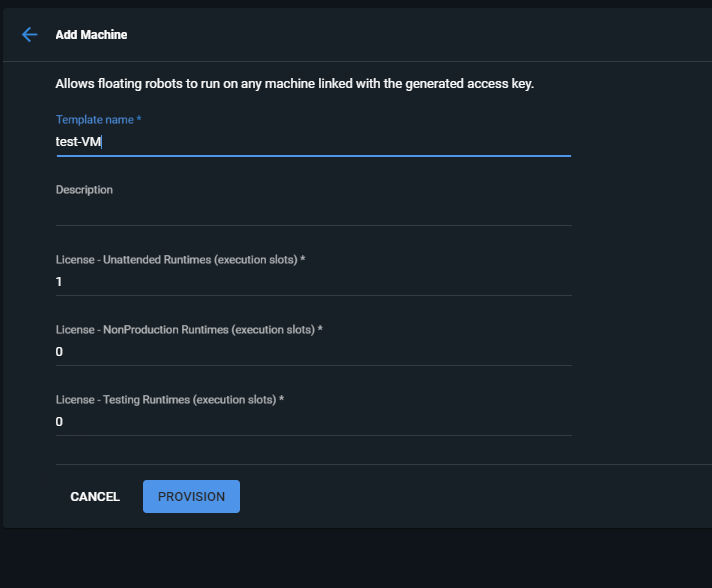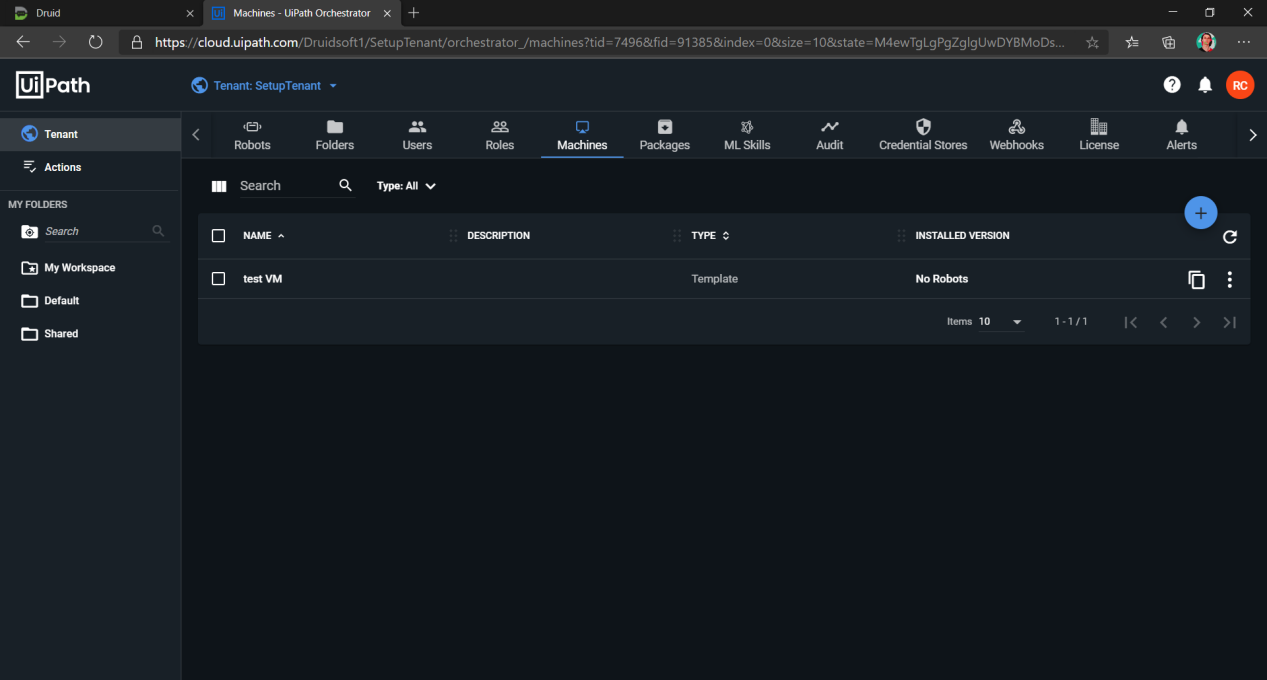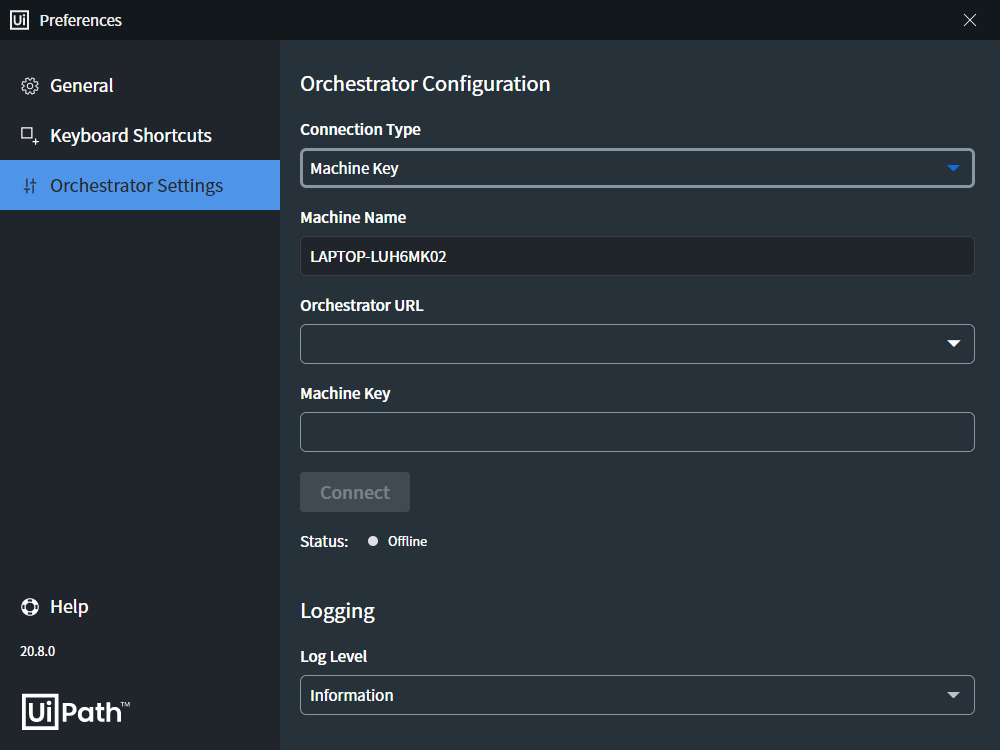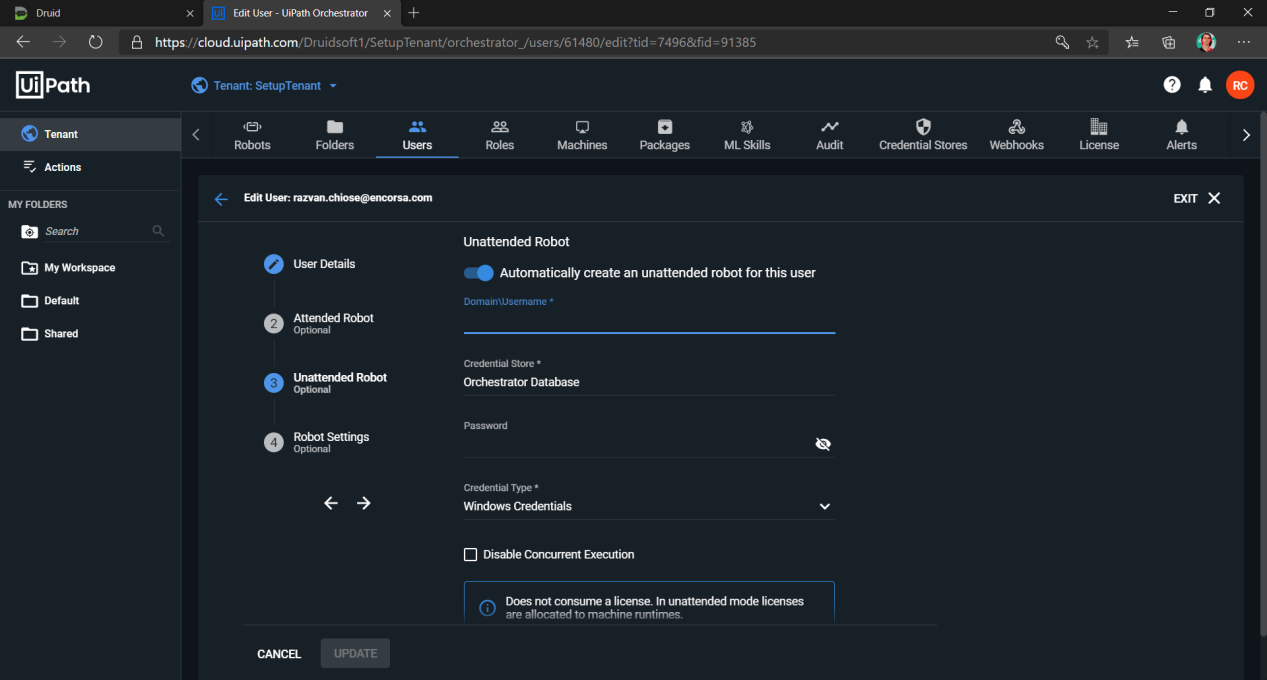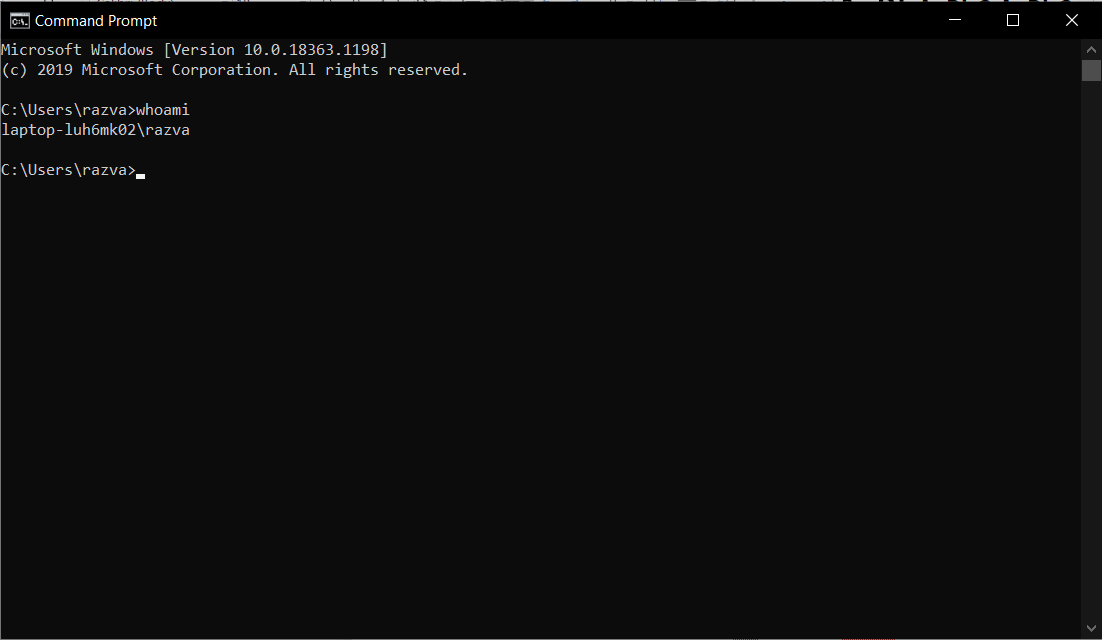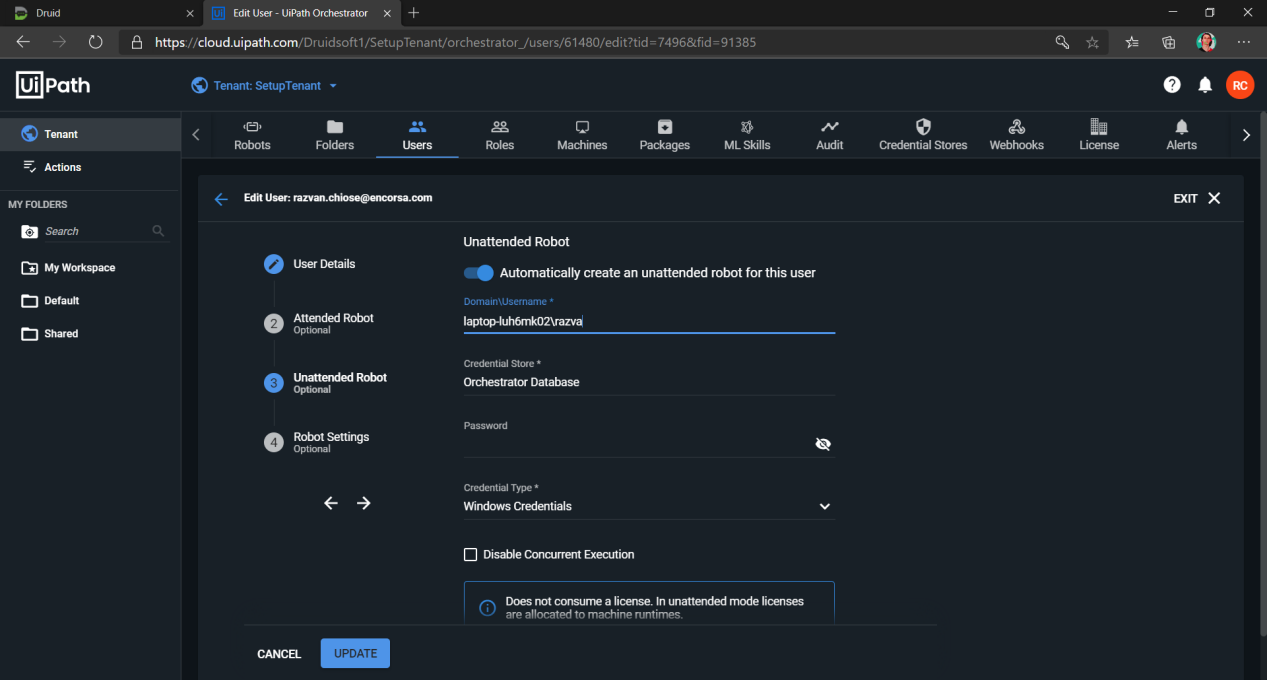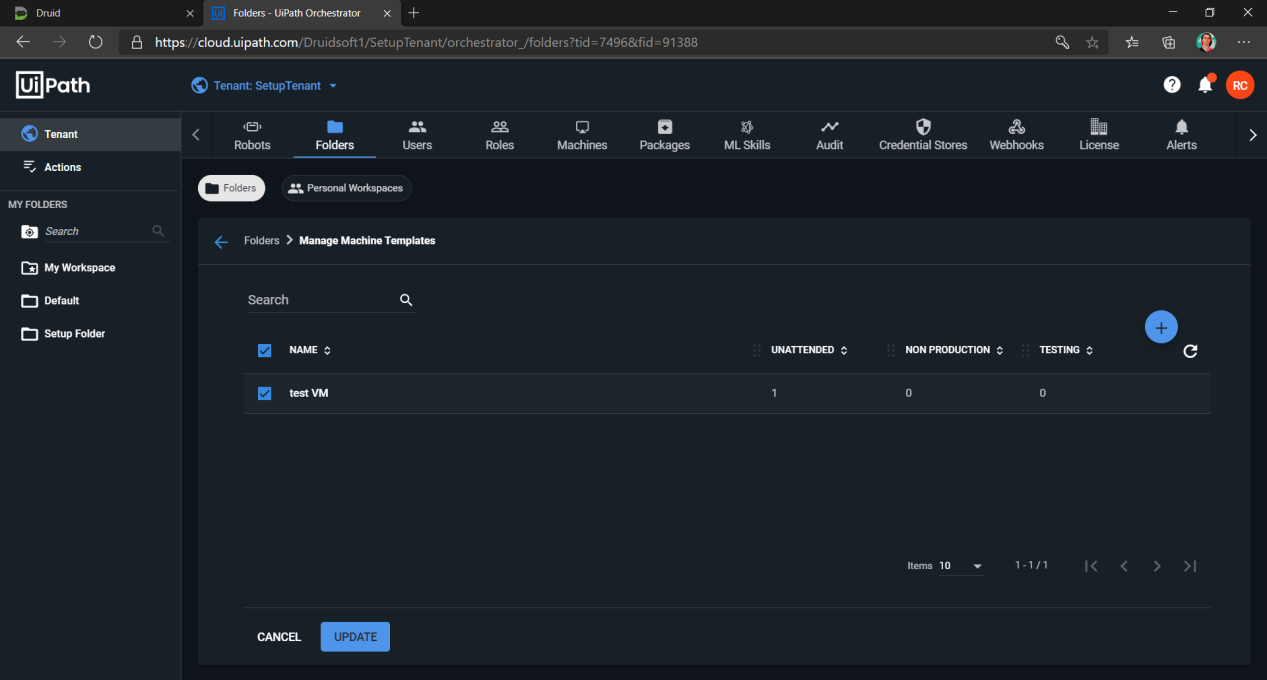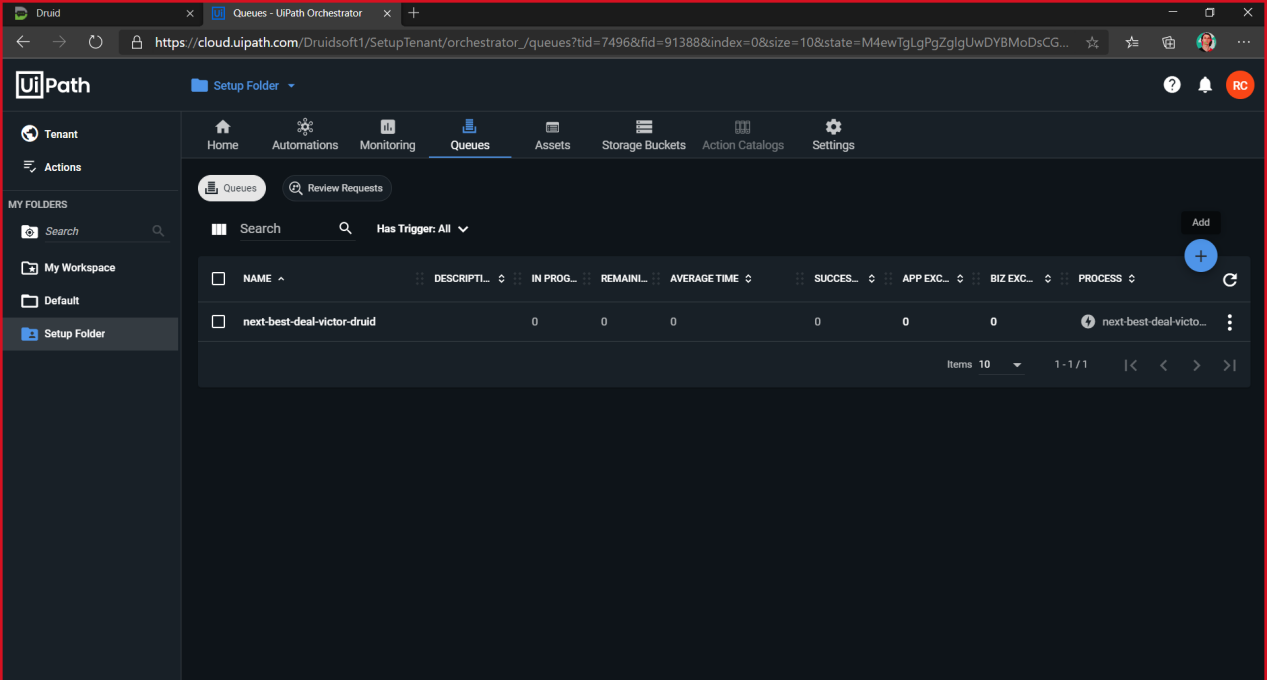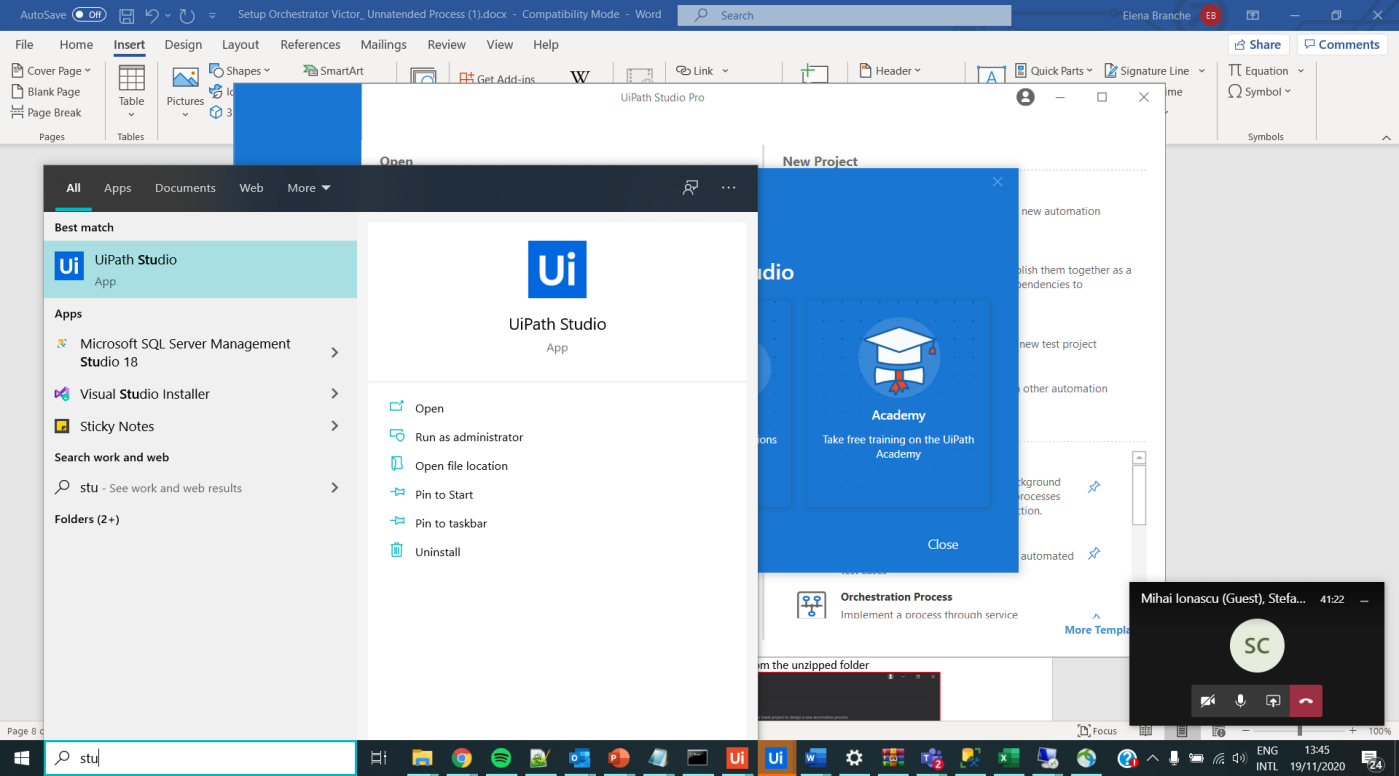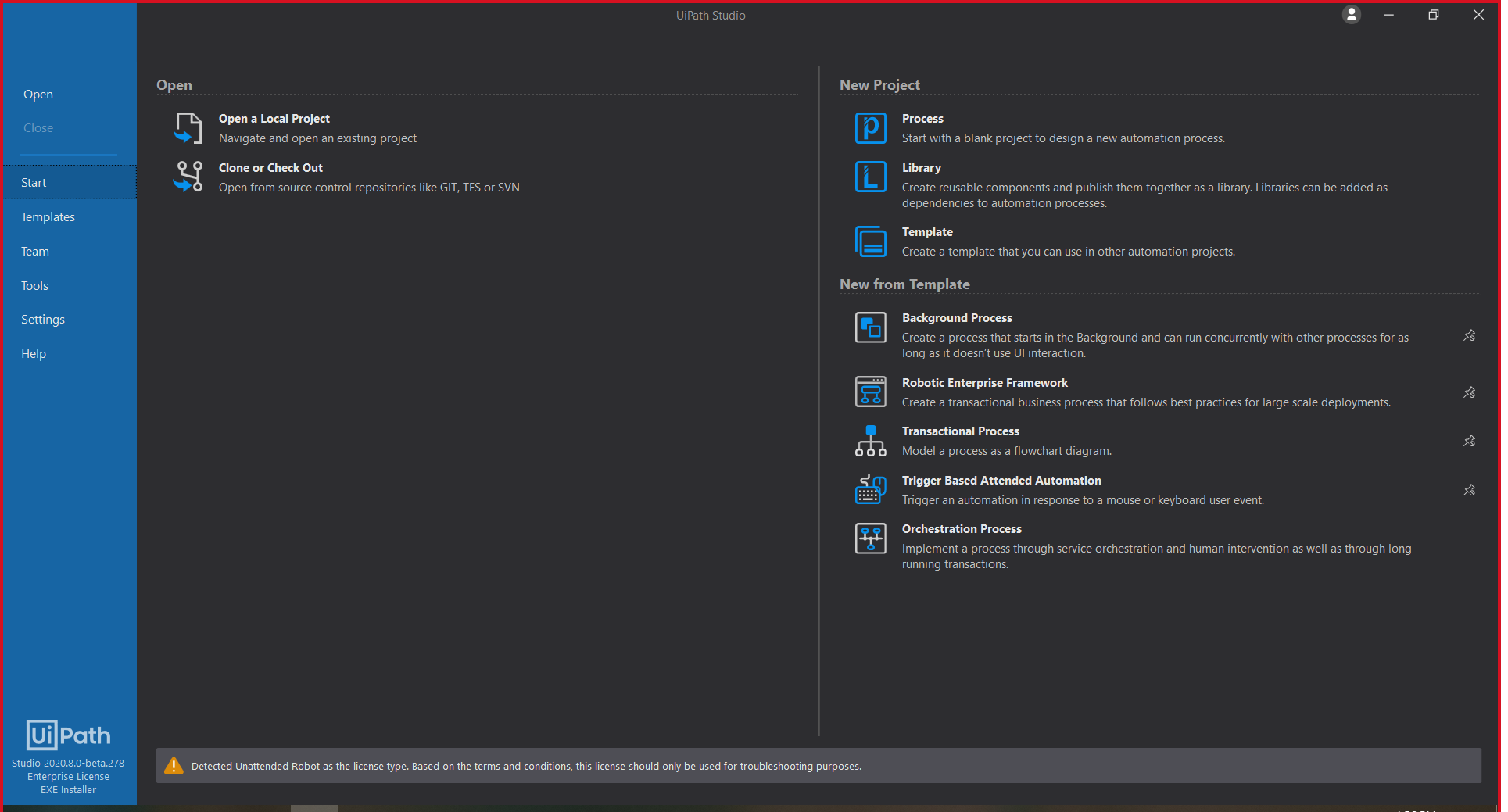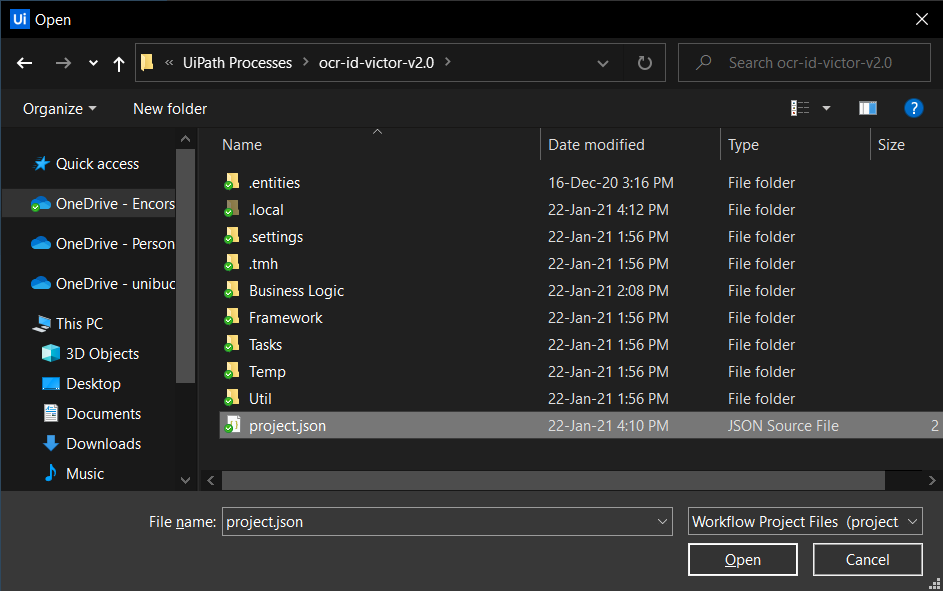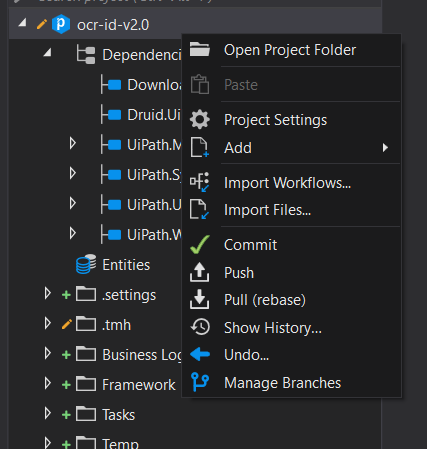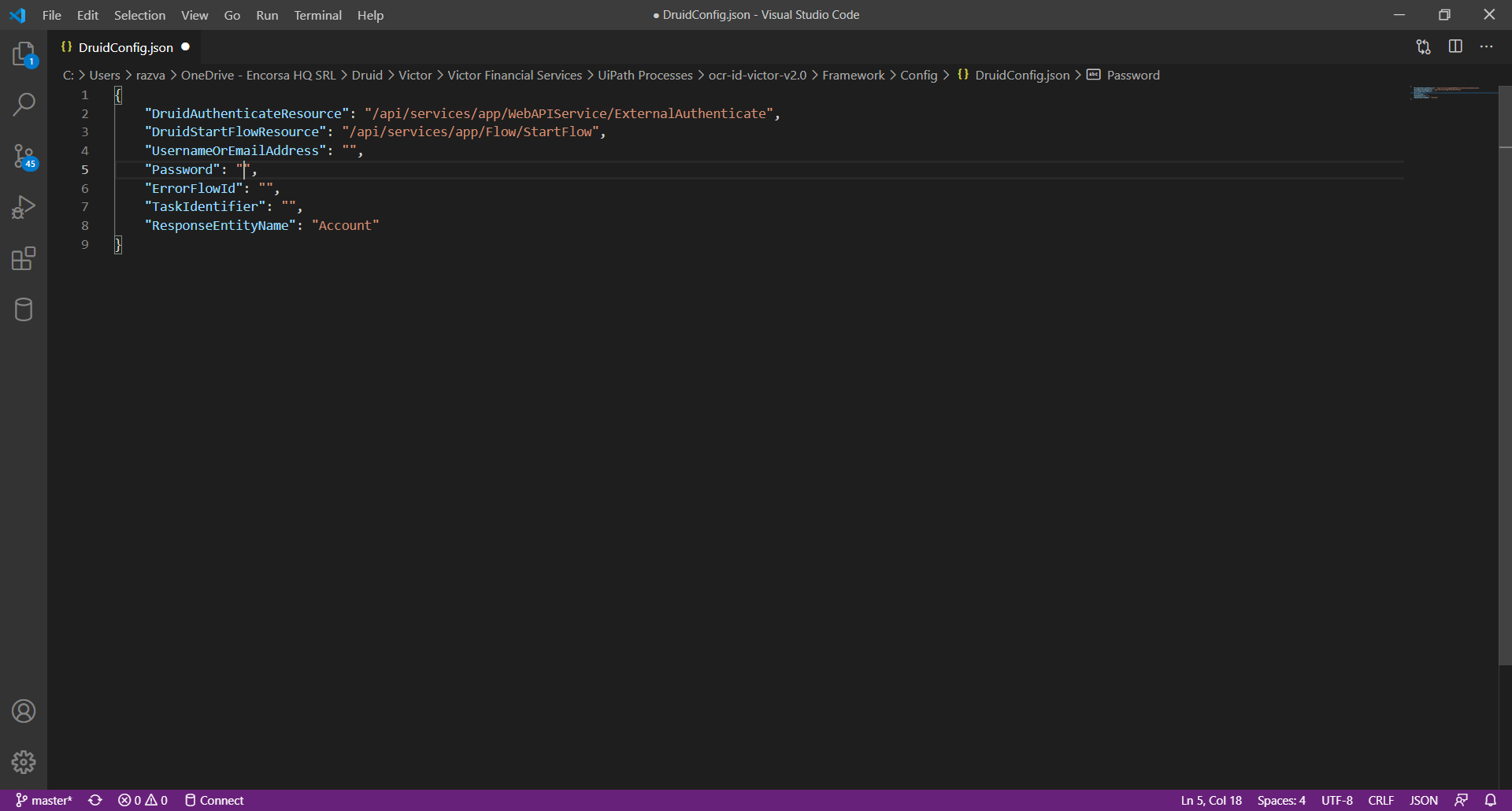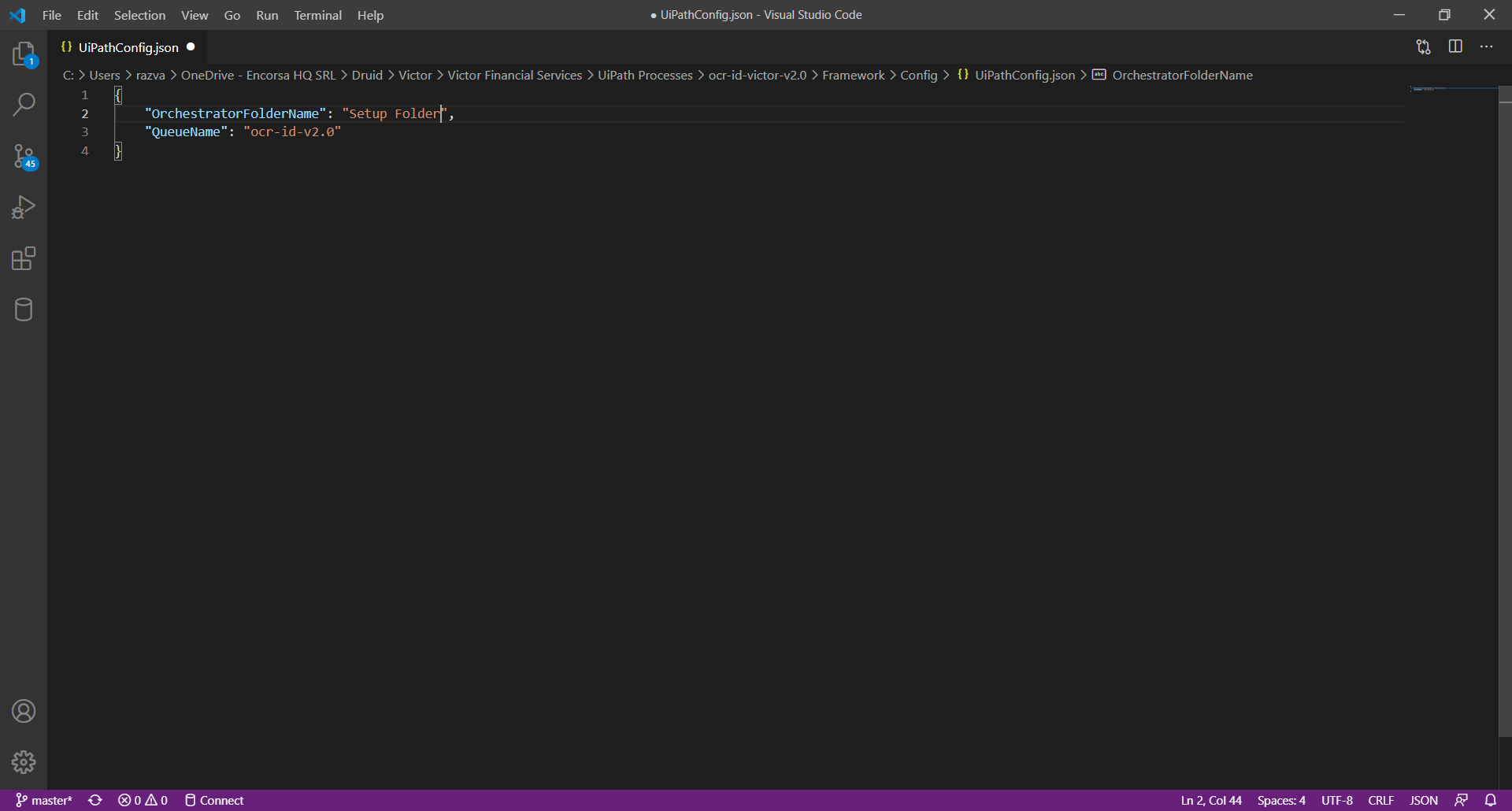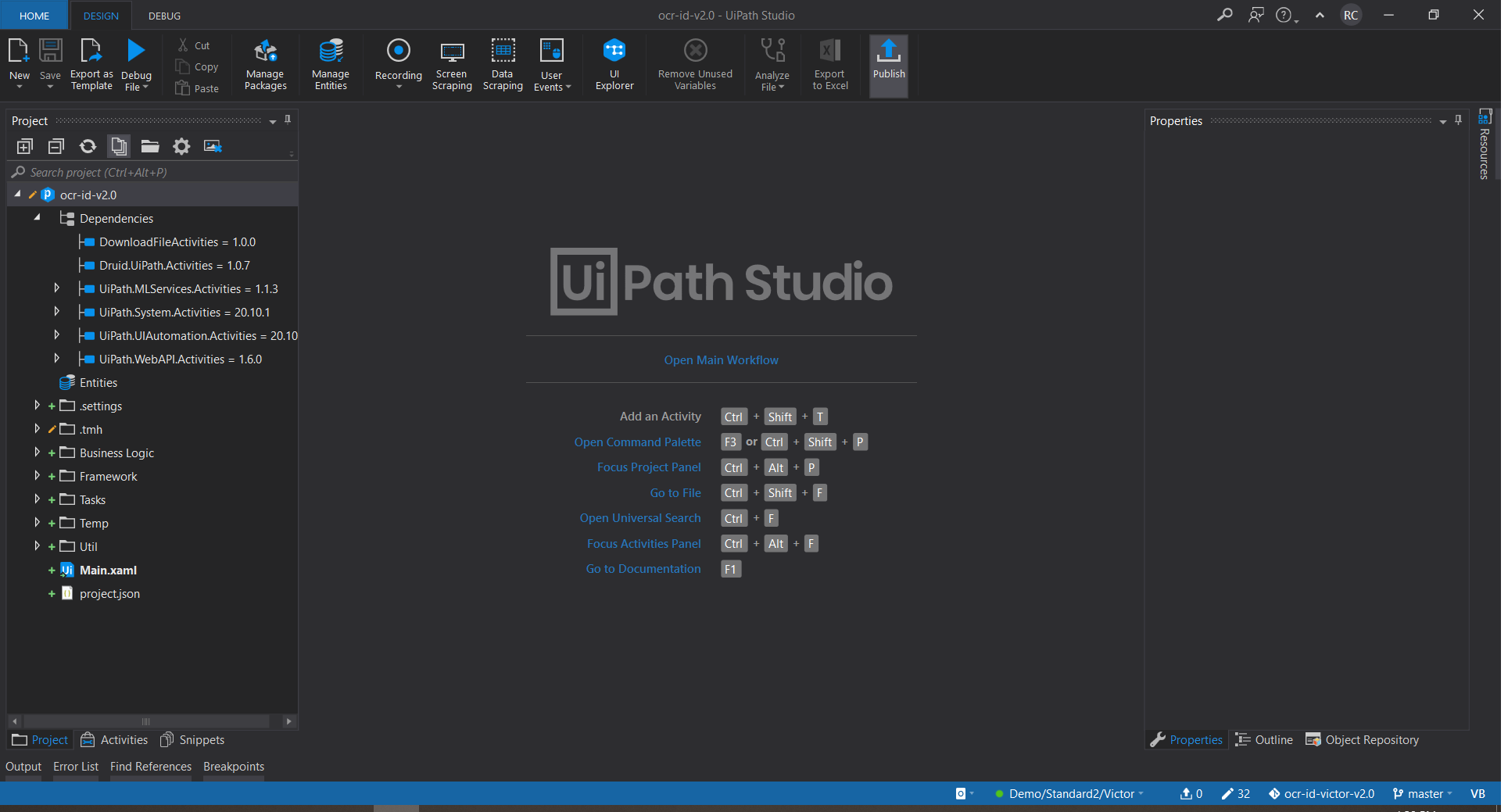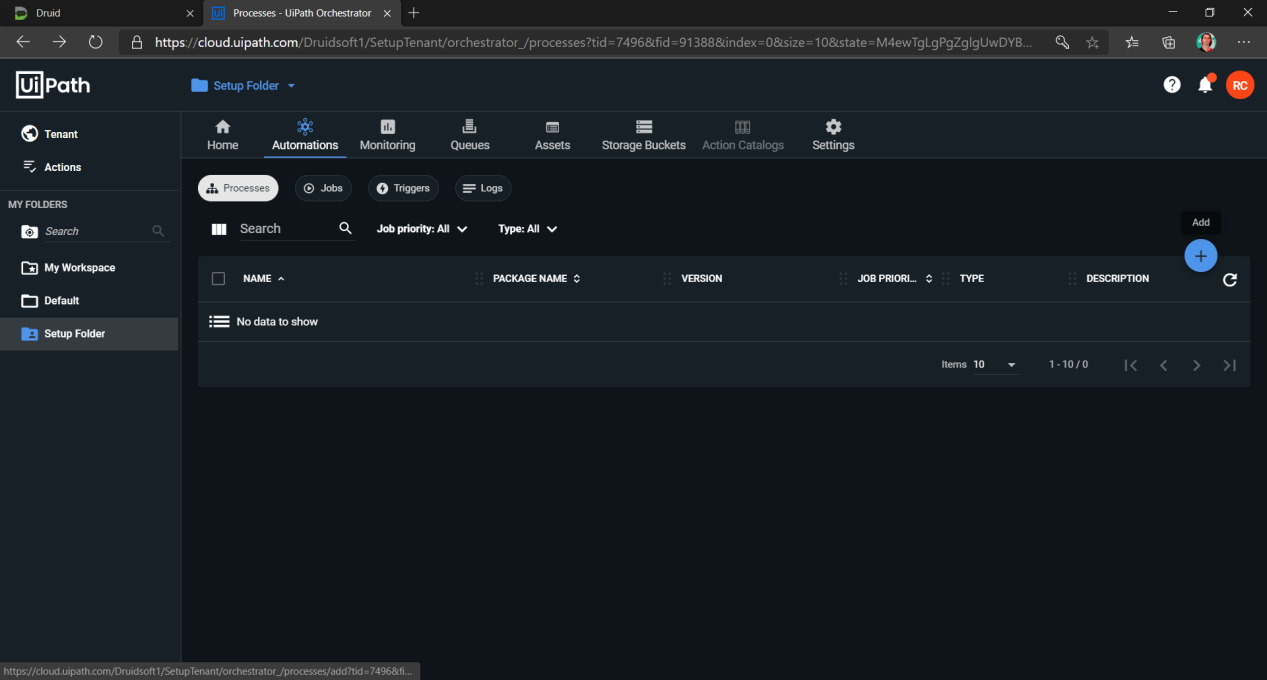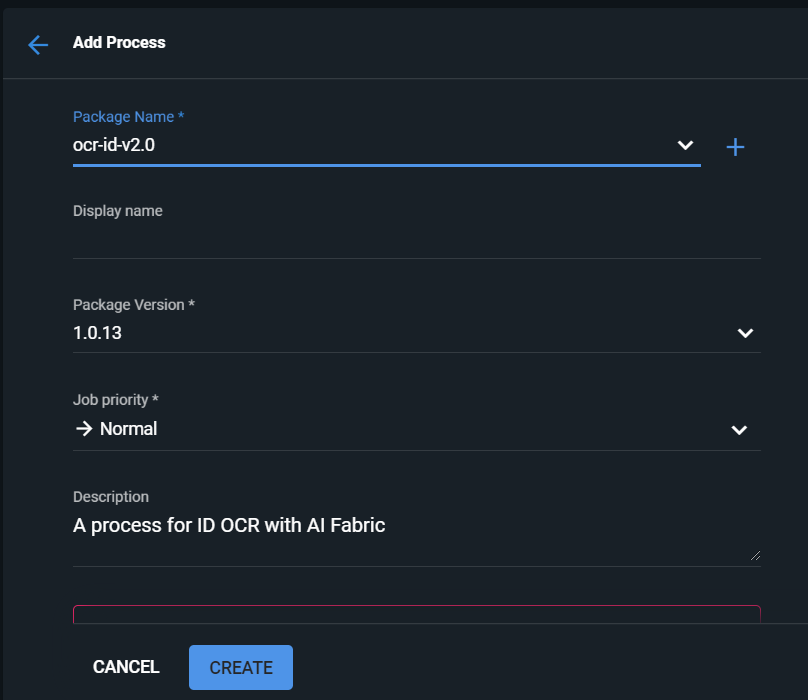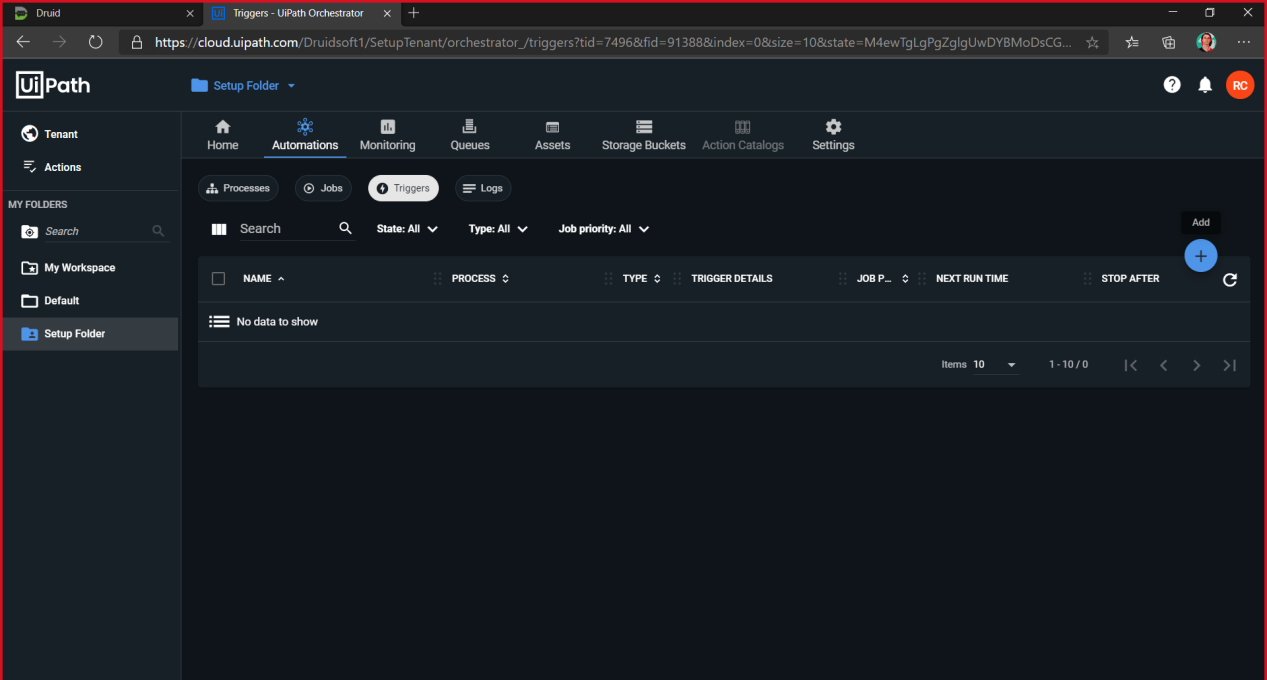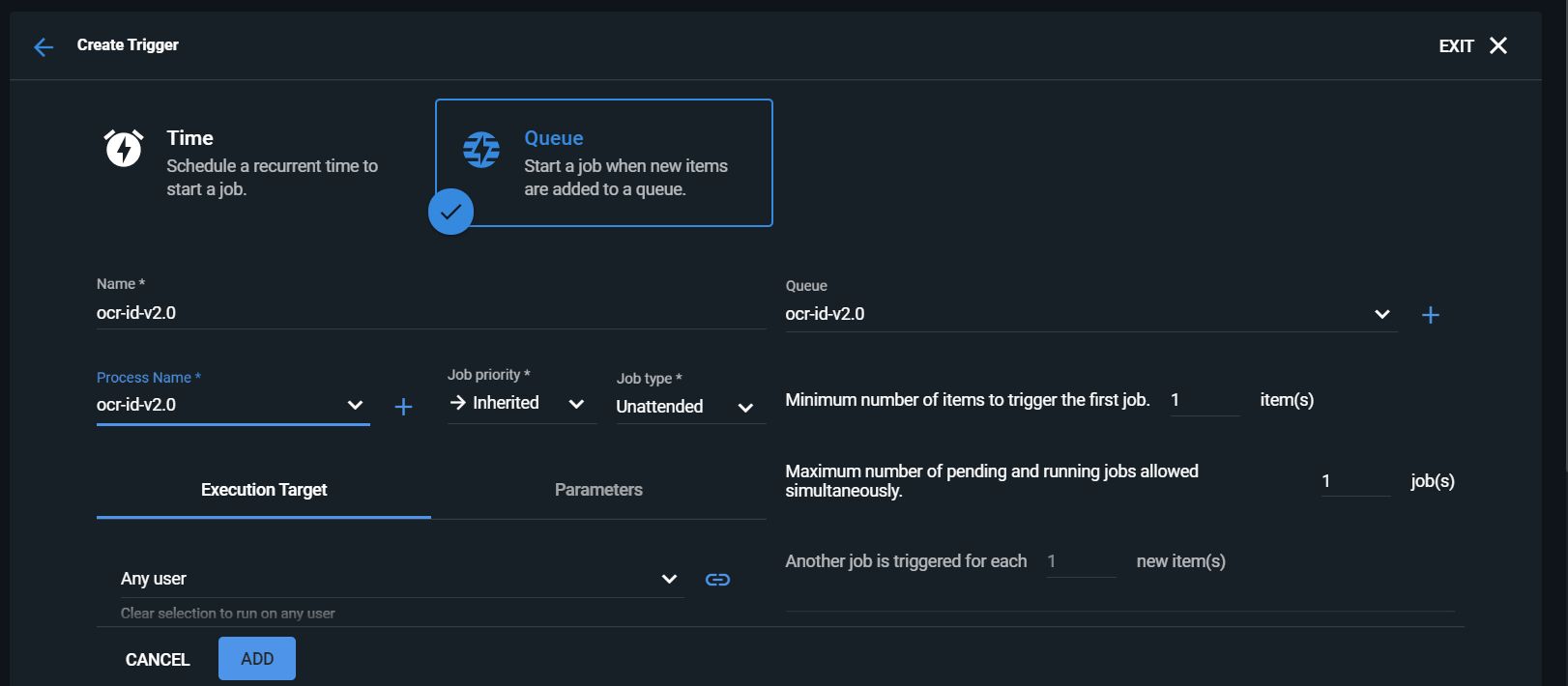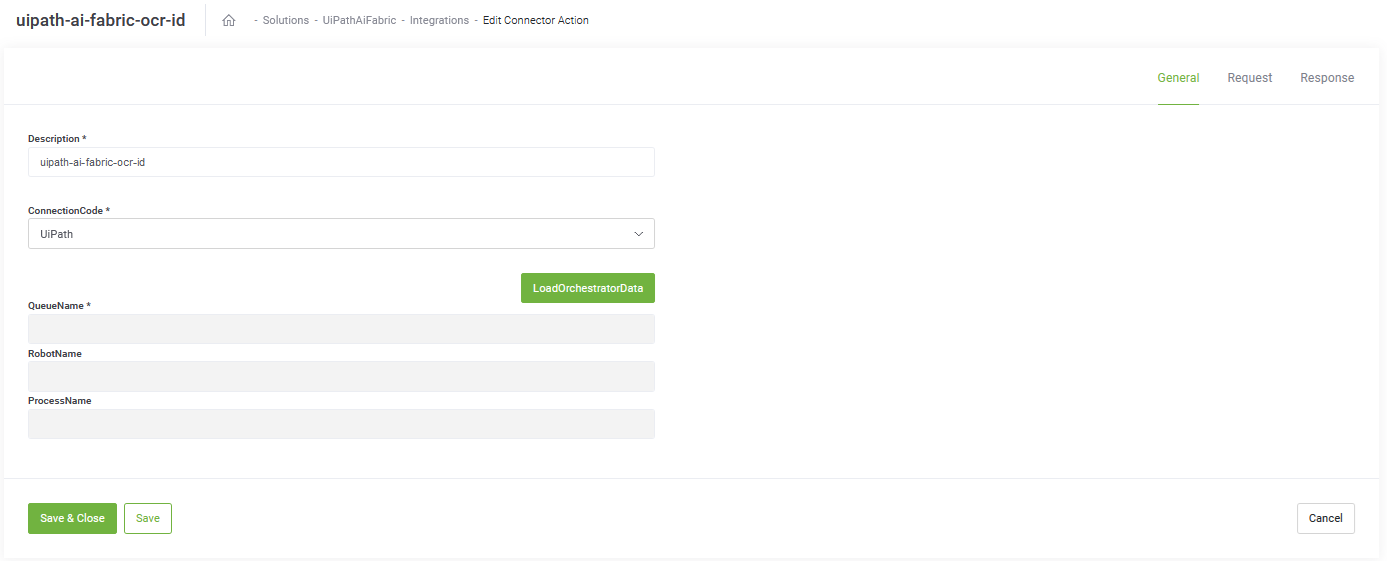Setting Up AI Center
Prerequisites
- You need UiPath Orchestrator.
- You need to have the UiPath Assistant. For more information, see UiPath documentation.
- Download the MrzDetect.zip file.
- Download the ocr-id-v2.0.zip file and unzip it.
To set up AI Center for Druid, follow these steps:
Step 1: Set Up UiPath AI Center
- Go to your Orchestrator tenant, on the main menu click AI Center and click the Create Project button.
- Give your project a name and a description and click Create.
- On the project main menu, click ML Packages. The packages page appears.
- Click Upload zip file. The Create new package page appears.
- Enter a Package name and in the Upload package field, select the MRZDetect.zip file you downloaded in the Prerequisites.
- From the Input type field, select file, and in the Output description field, enter json.
- Click Create. The package newly created appears in the ML Packages page and has the status "deployed".
- From the main menu, click ML Skills and create a new skill.
- Choose the package previously uploaded.
- Click Create. The skill appears in the ML Skills page and has the status “available”.
The Create new project page appears.

Step 2: Set Up UiPath processes for AI Center
- Log in to your orchestrator account.
- Download the UiPath Studio.
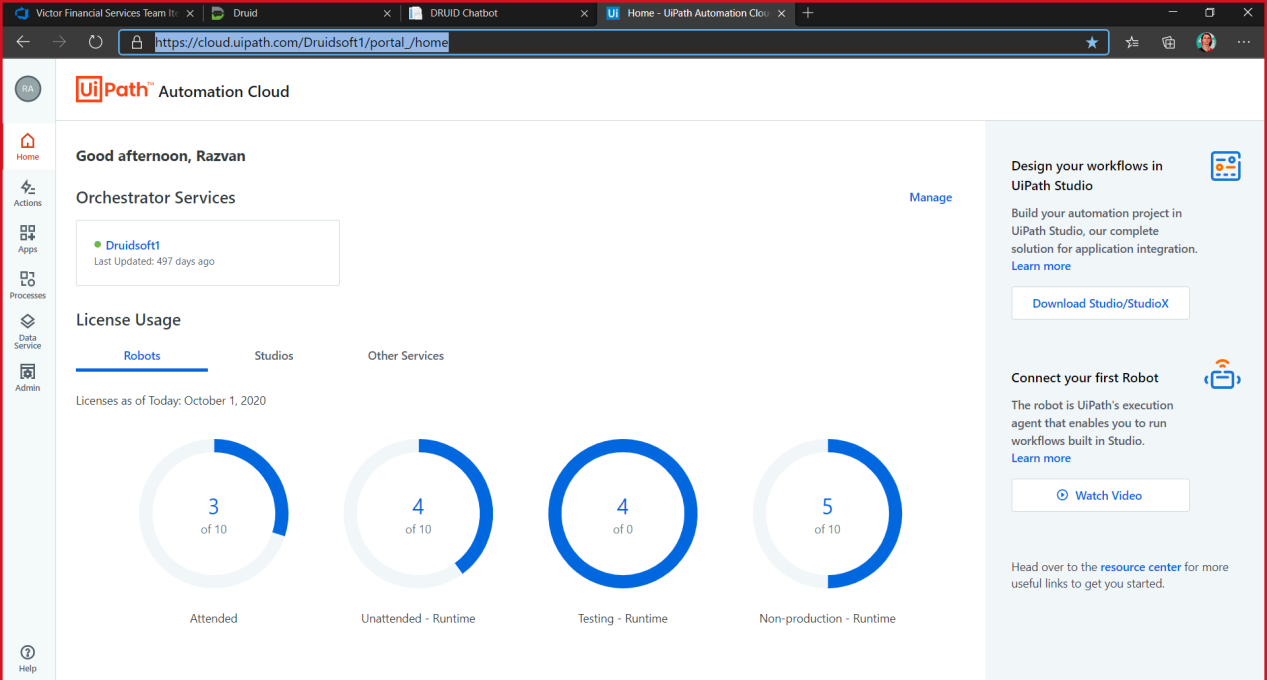
- Install UiPath on your computer.
- Click on the desired tenant (in our example, SetupTenant).
- Go to Tenant, click Machines and then click Add.
- Click Add Machine Template.
- Enter a Template name, Description and a License - Unattended Runtimes.
- Click PROVISION.
- Click Copy Machine Key to Clipboard.
- Copy the extended URL, you will need it later. In our example, https://cloud.uipath.com/Druidsoft1/SetupTenant/.
- Open the UiPath Assistant app.
- Click on Preferences.
- Click Orchestrator Settings and from the Connection Type drop-down, select Machine Key. The system automatically fills in the Machine Name field.
- Paste the Machine Key (from step 9) and Orchestrator URL (from step 10) and click Connect.
- Go to Tenant, click Users and search for your email address.
- Click the three dots on the right of your email address and click Edit.
- Go to the Unattended Robot section and tap on Automatically create an unattended robot for this user.
- Open the command prompt app and type in whoami. Copy the answer.
- In the Domain\Username field, paste the answer from the command prompt app.
- In the Password field, enter the password of the Windows account you use to log in on this machine and click UPDATE.
You successfully created a UiPath Floating Unattended Robot! - Go to the Folders tab and click New Folder.
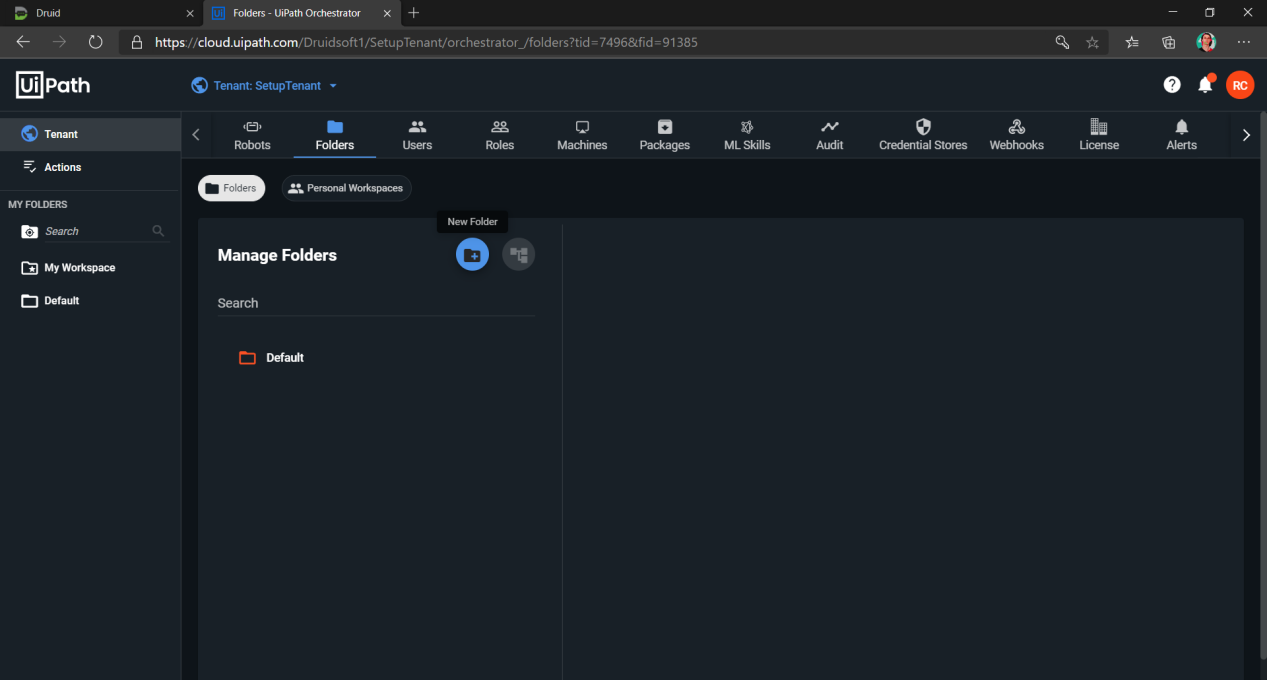
- Enter a folder Name, Description, select Modern as Folder type and Tenant package feed as Process packages source.
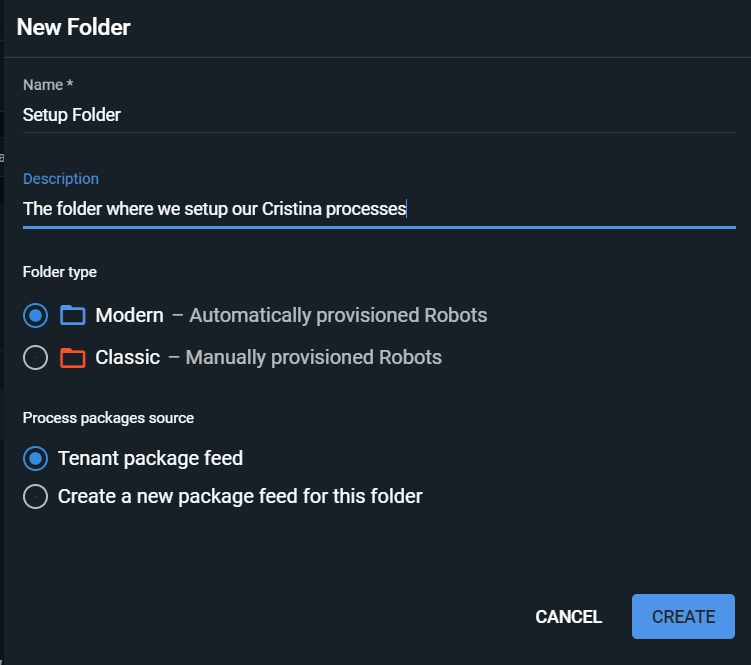
- Click CREATE.
- In the Tenant, click the Folders tab, select your folder, go to Machine Templates and click Manage Machine Templates.
- Select the Machine Template you created at step 7 and click UPDATE.
- On the left side on navigation bar, click the folder created at step 22. Click the Queues tab, then click Add.
- The Create Queue page appears.
- Complete the required fields and click ADD.
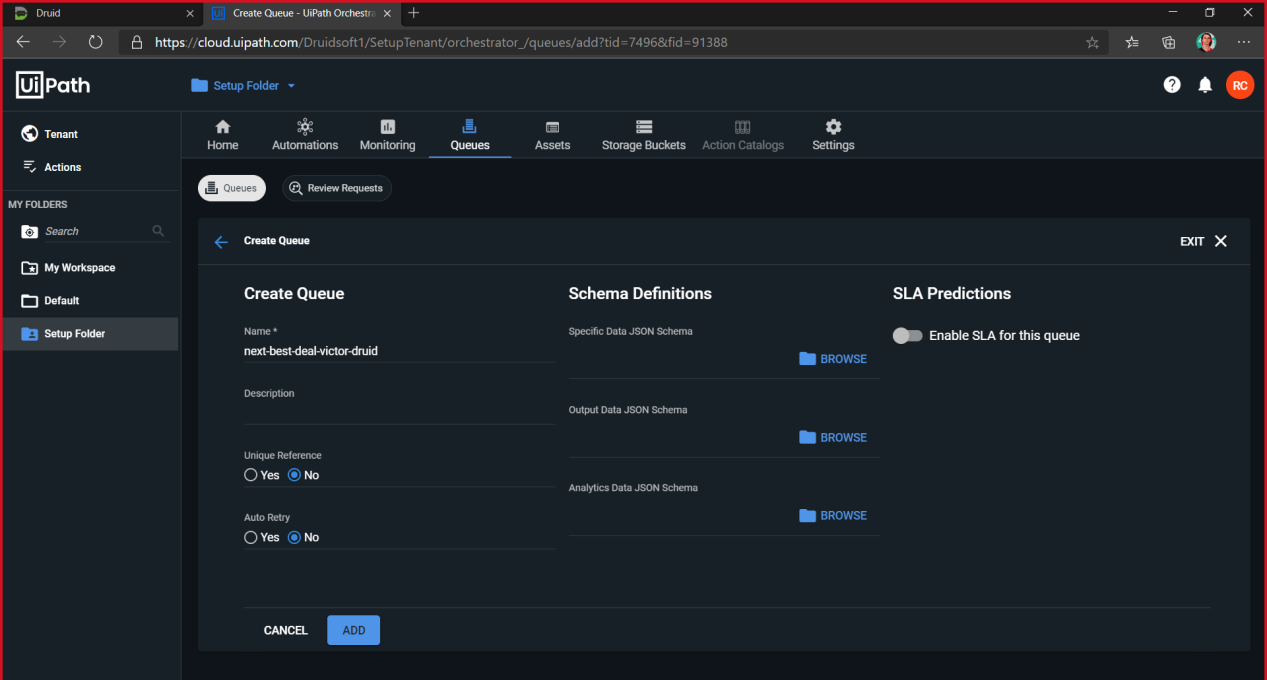
-
The queue appears in the Queues page. Write down the queue’s name, you need it later.
- Open UiPath Studio.
- Click Open a Local Project.
- Browse to the folder where you unzipped the ocr-id-v2.0.zip file (in the Prerequisites), select the project.json file and click Open.
- Right click on the process name and click Open Project Folder.
- Open the Framework folder, then the Config folder. There are two json files.
- Open DruidConfig.json. Complete all the fields as shown in the figure below.
- Save the file.
- Open UiPathConfig.json. Enter the folder name (from step 22) and the queue name (from step 29).
- Save the file.
- Switch to UiPath Studio and click Publish.
- Click Next
- Select Publish to Orchestrator Tenant Process Feed and click Publish.
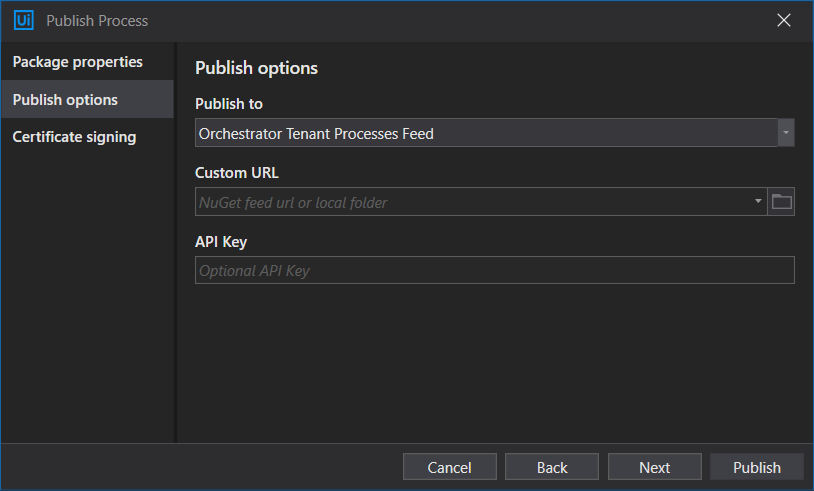
- In your folder, go to Automations > Processes and click Add.
- Choose the published package, enter a Process name and click CREATE.
- Go to Automations > Triggers and click Add.
- Click the Queue button. The Create Trigger page appears.
- Enter the trigger Name, select the Queue (from step 29) and the Process Name (from step 43).
- Click ADD.
- Switch to UiPath Assistant. Find the process from step 43, click the three dots on the right and click Install.
Fill in the username or email address and the password for a service account who has permissions to create a flow.
The Publish Process wizard appears.
You can now set up AI Center in Druid.
Step 3: Set Up AI Center in Druid
UiPath AI Center processes user files uploaded in chat. It uses Document Understanding and the extracted information is used in the conversational context. For example, the chatbot might ask the customers to upload the latest utilities bill and their identity card to check their address. Druid also uses AI Center to process image files (ID cards scan).
To set up UiPath AI Center, in the Druid ChatBot Portal:
- Go to UiPathAiFabric Flows and click on the flow ocr-identitycard-using-AiCenter.
- Click the Details tab, click the General section header and write-down the FlowID.
- Click the Steps tab, go to step process-mrz and click the edit icon.
- In the Set Variables section, for variable [[Account]].ResponseFlowId paste the FlowID copied previously.
- Click Save.
- On the main menu, click Integrations and search for uipath-ai-fabric-ocr-id.
- Click on it. The Edit Connector Action page appears on the ConnectorSteps tab.
- Click to edit the only connector step available (that is, uipath-ai-fabric-ocr-id).
- Click the Load Orchestrator Data button and choose your QueueName.
- Click Save & Close.
